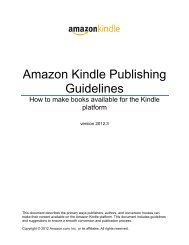Amazon Guidelines
Guidelines for self created
Guidelines for self created
You also want an ePaper? Increase the reach of your titles
YUMPU automatically turns print PDFs into web optimized ePapers that Google loves.
<br />
3.6 Table <strong>Guidelines</strong><br />
Publishing on Kindle: <strong>Guidelines</strong> for Publishers<br />
3.6.1 Table Guideline #1: Use Tables for Tabular Data Only<br />
IMPORTANT: Use tables for tabular data only. Although it is common practice to use tables for layout in<br />
websites, this is not allowed in Kindle books. Do not use tables for dialogue, transcripts, chronologies,<br />
tables of contents, lists, sidebars, and so on.<br />
3.6.2 Table Guideline #2: Avoid Large Tables<br />
A table rendered as an image cannot be paginated, and the whole image is drawn on one screen. If the<br />
table is rendered using HTML tags, pagination is available and users can cursor through the<br />
cells in the table. If the table is significantly wider than the screen and forces panning, it is a poor user<br />
experience.<br />
For the best user experience, please respect the following rule: tables should not contain whole<br />
paragraphs of text or large pictures in a cell.<br />
If a table is too large or contains too much text in its cells, consider reformatting it in a way that enables<br />
legible text for the customer to view.<br />
In the example below, rotating the table to better fit the screen does not help. To preserve the format and<br />
layout of the data, it would be better to have the paragraph text as plain HTML and only the right-most<br />
column rendered as an image or HTML table.<br />
Large table rendered as an image: illegible text, The same content, reformatted as HTML and resulting<br />
unacceptable quality<br />
in a legible, good-quality table<br />
Vitamin C<br />
Functions/Roles in Metabolism<br />
Antioxidant; biosynthesis of connective tissue<br />
components (collagen, elastin, fibronectin,<br />
proteoglycans, bone matrix, and elastin–associated<br />
fibrillin); carnitine, and neurotransmitters<br />
Deficiency Symptoms<br />
Scurvy (involves deterioration of elastic tissue);<br />
follicular hyperkeratosis, petechiae, ecchymoses,<br />
coiled hairs, inflamed and bleeding gums, perifollicular<br />
hemorrhages, joint effusions, arthralgia, and impaired<br />
wound healing; dyspnea, edema, Sjögren syndrome,<br />
weakness, fatigue, depression<br />
Toxicity Symptoms<br />
Nausea, abdominal cramps, and diarrhea (from<br />
supplements)<br />
Kindle Publishing <strong>Guidelines</strong> <strong>Amazon</strong>.com 20



